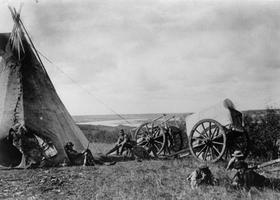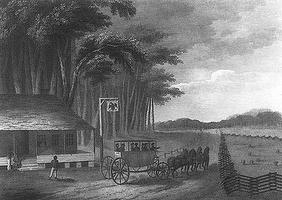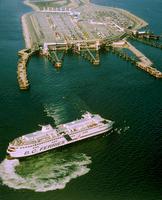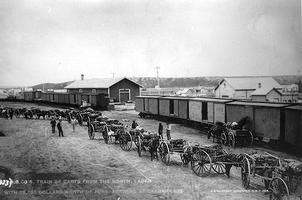The importance of transportation to a trading nation as vast as Canada cannot be underestimated. The great distances between mines, farms, forests and urban centres make efficient transport systems essential to the economy so that natural and manufactured goods can move freely through domestic and international markets. Transportation has and will continue to play an important role in the social and political unity of Canada.
History of Transportation
Canada's history is closely tied to the history of transportation and its development. The first settlers ventured only into those areas that were accessible by water and boats; canoes were the primary mode of transportation on the nation's lakes and rivers. Later, canals were constructed. Settlement in much of Canada followed the construction of railway lines. Roads and highways later gave access to regions of Canada that had not been served by railways. Today, air transport makes it possible for Canadians to travel to any area of the nation, regardless of how remote it may be (see Transportation in the North).
Railways have always been important in Canada. They were built to open new areas to settlement, to make profits for the railway builders, to unify the nation, and for defence and political reasons. The first railway line in Canada was built in 1836; some ten years after England built its first steam railway line. In the 1850s railway construction began in earnest with the Grand Trunk Railway from Sarnia through Toronto and Montréal to Portland, Maine. In 1854 the Great Western Railway built a line between the Niagara and the Detroit rivers via Hamilton. It connected with US railways in New York and Michigan. Much of this early railway construction resulted from a speculative boom in which some promoters sought to make quick profits. As a result many railways were poorly planned and constructed. Much of the early railway construction was financed by British capitalists, Canadian merchants and landowners, and by municipalities. Some construction was financed by bonds.
The Intercolonial Railway was the largest system. Completed in the 1870s, it was built for national defence and unity, in fulfilment of the terms of Confederation, and was never expected to make a profit. Many of Canada's rail lines had financial problems. When it appeared that a number of them might collapse, they were amalgamated into the Canadian National Railways system and taken over by the federal government after the First World War. Many financial problems were thus inherited by that government-owned corporation.
Railways were responsible, in part, for some of the provinces joining Canadian confederation. It was not until the federal government agreed to build a railway to the Pacific Ocean that British Columbia agreed to join, an agreement that led eventually to construction of the western sections of the Canadian Pacific Railway. Transportation also played an essential role in the history of Prince Edward Island, which was at first unenthusiastic about Confederation; the severe financial problems of its railway played a large part in the decision to join Canada in 1873. Part of the confederation arrangement provided that the federal government would assume the railway's enormous debt. Newfoundland and Labrador, the last of the provinces to join Canada, also received guarantees from the federal government that it would be provided with various transport services.
Modes of Transportation
There are five principal modes of transportation in Canada: water, rail, motor carrier, air and pipeline.
Water Transportation
Water transportation is generally used for the movement of bulk commodities of relatively low value per tonne, such as coal, ore, grain, gravel and salt. Water transportation may be separated into three general categories: ocean transportation, inland water transportation and coastal transportation. Ocean transportation is important to Canada because about one-third of all that Canada produces is exported by ship to customers overseas, carried by large, oceangoing vessels that serve Canada's major ports. Canadian and American lake carriers and other vessels operating on the Great Lakes and in canals and inland waterways supply goods to inland regions of Canada. For example, much of Canada's iron ore moves via the Great Lakes-St Lawrence Seaway system to steel mills in the US. On the return journey, many of these vessels carry coal from US mines. Transportation in coastal waters is also important. Logs, wood chips, lumber and other bulk commodities are moved by barge in BC's coastal waters (see: Forest Harvesting; Ports and Harbours; Shipping Industry).
Rail Transportation
Rail transportation is used principally for the movement of bulk commodities such as grain, coal, ore, lumber and chemicals, for the movement of containers and for other types of merchandise freight. Canada's major mainline rail carriers include Canadian National (CN) and Canadian Pacific (CP). Rail transport offers an efficient means of transport because entire containers can be moved between trains, trucks and ships. Each year Canada's railways move millions of tonnes of bulk commodities, such as coal, potash, grain and sulphur. Railways are able to transport large quantities of bulk materials over long distances and at relatively low cost, thus enabling the products of Canada's mines, fields and forests to compete effectively in world markets.
For many years passenger trains represented an important part of the railway business. Today, however, railway passenger trains face intense competition from other forms of transport. Via Rail Canada Inc. is now responsible for most of the passenger train operations, particularly in the Windsor-Québec corridor, by contracting with the two major railways for the operation and maintenance of trains. After suffering significant losses in the 1980s, VIA Rail discontinued service on several lines, but continues its cross-country passenger rail service.
Motor Carrier Transportation
Trucks are used in a variety of ways. Small trucks are used as delivery vehicles in cities and towns. In the North, trucks transport logs, petroleum, consumer goods and a great variety of industrial products. Possibly the greatest virtue of motor carrier transportation is its flexibility. They can move wherever there is a highway, a road, a street – or even a relatively flat, hard surface. Virtually everything that we eat or wear has made at least some of its journey to us by truck (see Trucking Industry). A number of large companies operate trucks. Both of Canada's major railways have trucking divisions.
Air Transportation
Air transportation is used to move large and small items when speed is important or when remote areas are inaccessible by land or water (see Aviation). Extensive deregulation of the air transport industry in the mid-1980s favoured the domination of major companies such as Air Canada. The 1995 Open Skies agreement between the US and Canada resulted in an explosion of trans-border services. The National Airports Policy (NAP) was established in July 1994. Under the NAP, the federal government changed its role from airport owner and operator to owner and landlord, but maintained its function as regulator.
Pipeline Transportation
Pipelines, the unseen carrier, are used for the transportation of petroleum, petroleum products, gas and certain chemicals. Pipelines transport enormous quantities of petroleum, gasoline, chemicals and other products, sometimes over long distances. Pipeline transportation requires little labour and is relatively trouble-free because it provides reliable and low-cost transportation. However, it has two principal drawbacks: pipelines require an enormous amount of capital to establish; and they are seldom efficient unless large quantities of product are moved from a single point of origin to a single destination over a long period of time. Pipelines are also used for the transportation of bitumen from Alberta oil sands projects.
Intermodal Transportation
Except for items moved by truck, virtually all other methods use two or more transport modes. Large shippers often have several transport alternatives available to them (e.g., rail, water, truck). The shippers of petroleum, chemicals and other products in liquid or gaseous form also use pipelines. Passengers usually have several transport alternatives available. Because of competition between modes and companies, there is a continuing need for research to improve transport technology. "Piggyback" transportation is an example. Goods may be loaded into trucks or trailers and hauled to some point on a railway where the truck or trailer is loaded on a railroad flatcar. The goods then move by rail, sometimes over a relatively long distance. At the end of their rail journey, the trailers or containers are again moved by truck to their final destination.
There are other ways in which the various transport modes can co-operate to provide more efficient intermodal transportation. Trucks can be carried on ferries or ships. This is sometimes called "fishyback" transportation or Ro/Ro (roll on/roll off) transportation. Canada Steamship Lines operates the largest fleet of self-unloading bulk carriers in the world.
Canada's "land bridge" is also based on intermodal operations. Shipments from Japan and Hong Kong destined for Europe can move by ship via the Panama Canal. Or, by using Canada as a land bridge, they can move by water to Vancouver or other western ports, then by rail to one of Canada's eastern ports, and again by water to their European destinations, saving a significant amount of time.
Transport Infrastructure
Every mode of transportation has two essential parts: the transport vehicle itself; and the road, track or infrastructure on which it operates. When two modes of transportation are coordinated, there may be a junction or terminal at which the transfer is made. Some of the transport infrastructure is natural, but much of it is constructed (see: St Lawrence Seaway; Track and Yard; Airport). Transport Canada, and its predecessors, built, maintain and operate most of Canada's airports, as well as the airways, and the radio and navigation systems. Most of Canada's roads and highways have been built by provincial governments, the major exceptions being highways in national parks and Aboriginal reserves, the Alaska Highway and the Trans-Canada Highway (see Roads and Highways). Most streets have been built by cities and have been financed in a variety of ways. Users of airports, seaway locks and port facilities pay landing fees, lockage fees and port duties to compensate in part for the taxpayers' investment.
Passenger Transportation
Passenger transportation includes many modes of self-propelled, animal-propelled and motorized travel, including planes, trains, boats, buses, automobiles, taxis, manual and electric bicycles, horses, snowmobile or dogsled. The automobile accounts for the greatest percentage of passenger travel in Canada today as well as much of the congestion in and around urban roadways. Most of Canada's urban areas have some form of public transportation. Both Montréal and Toronto are served by commuter railway systems. Some cities have subways, while others are served by buses (see Bus Transportation), streetcars, electric trolley cars or a mixture of vehicle types. Some urban transportation systems are operated by the cities themselves, some by regional districts and some by special transit authorities. Many cities provide parallel transit services for people with disabilities.
Most Canadian cities have taxi service. In some cities a licence is required to operate a taxi, and a limited number of licences are issued. Some taxi companies enjoy a monopoly. One or more companies may be given the exclusive right to pick up passengers at airports, railway stations or other areas where passengers originate. The largest ferry system in Canada is operated by the BC Ferries, providing service between the Vancouver area and the cities of Victoria, Nanaimo, many of the Gulf Islands and some remote northern communities. There are ferries on Canada's East Coast, and on some of its lakes and inland waterways. Ferry service is provided from New Brunswick to PEI, although most passenger traffic occurs via the Confederation Bridge.
Technological Change
New inventions, technological change and human ingenuity have resulted in many changes in Canada's transport. Most changes have meant greater speed, lower cost or increased productivity. Some have made possible the development of entirely new industries. Recent advances in water transportation have resulted in greatly increased productivity. Some improvements have come through the development of larger ships that carry far more cargo than earlier ships. As large ships seldom require more crew members than smaller ships, crew productivity has increased, and shipping costs have been reduced. There have been advances in navigation, ship design and ship propulsion. Research has been done on the use in ships of powdered coal and other petroleum extenders, and substitutes for fuelling ships. Still other increases in productivity have resulted from the use of containers. Today, enormous cranes at a modern port may load a large oceangoing liner with containerized freight in half a day. It would have taken three or four days to load that freight before the shift from manual loading of freight to the mechanical loading of containers. Much of the savings stems from ships spending less time in port. This makes it possible for them to move more cargo each year, since they can spend a greater portion of their time at sea.
Railway productivity has also increased in recent years through the use of more efficient railway cars, some of which were specially designed to carry a particular product (such as grain or coal). Other increases in productivity have come from the use of longer trains, robot locomotives and better train scheduling. Robot locomotives, placed near the middle of trains, make it possible to use longer trains. The train engineer can effectively handle five or six diesel locomotives and control a train more than a kilometre long, even in mountainous areas. Better communications and electronic signals systems make it possible to operate far more trains over a track than was possible with more primitive manual signals. Less space is required between trains, and especially between trains going in opposite directions on a single railway track.
With a modern control system the railway dispatcher can determine the location and speed of every train quickly and electronically. The dispatcher is able to plan train movements carefully and to shunt approaching trains onto railway sidings so that other trains may pass. This makes it possible for more trains to use the track and thus increases railway productivity. Other improvements have come from more efficient use of railway cars, locomotives and other expensive equipment. Much research has focused on the linear induction motor which is highly efficient and enables trains to accelerate and decelerate more rapidly. These motors are used in LRT (light rapid transit) trains.
Aviation technology has changed radically in recent decades and operates more efficiently. Modern jets are much larger, quieter and more fuel efficient than earlier models. Aviation technology is changing in other areas too. Modern conveyor belts handle passengers' baggage faster and more efficiently. Photoelectric cells and other devices "read" baggage labels, and robots direct baggage and freight to specific bins and carts so that they can be quickly loaded onto aircrafts. Better radar and other electronic devices have been developed to enable planes to operate more reliably in bad weather. Aviation technology is also changing on the ground. Airlines have developed better systems for reservations and ticketing. Canadians can now order and pay for their tickets electronically and within minutes.
There have also been significant increases in productivity in the motor carrier industry. Some increases have resulted from the use of trucks and trailers which are longer, wider and higher. Other productivity increases have come from utilizing more of the available space and in scheduling vehicles more efficiently. Some provinces permit a truck (or tractor) to pull more than one trailer. As a truck requires little more fuel to pull two trailers than one (and only one driver is required), trucks which pull two trailers can be more efficient. Motor carrier productivity has also increased because of the development of more fuel-efficient engines and because of experimentation with the use of lower grade fuel. In some cities the cost of urban transit has been reduced by the introduction of articulated buses (two passenger units pulled by a single engine). Such buses have been used in European cities for some time.
In pipeline transportation, productivity has increased due to the use of larger pipes and faster speeds. This has been made possible by technological improvements in valves, compressors and friction-reducing agents.
Transportation and Communications
The transportation and communications industries have always been related. When good communications are established with another country, trade will often follow. Certainly, there cannot be much trade without good communications. Some system has to be available for the transmission of orders and the movement of shipping documents and other shipping details. In these areas transportation and communication are complementary. In other areas they may compete. Personal transactions have been replaced in many instances by electronic communications. As transport costs increase and better communications systems are developed, transportation and communications will compete increasingly in certain areas (see Computer Communications; Communications Technology; Telecommunications).
Transportation and Travel
The availability of comfortable, convenient and relatively low-cost transportation (by air, train and bus or automobile) has encouraged the development of the travel industry — one of the fastest-growing segments of the Canadian economy (see Tourism). Much of this development results from co-operative arrangements between transportation companies, travel agents and the operators of hotels, car rental agencies and other such facilities. Tour packages that include hotels, meals, guides and other items are frequently arranged by a tour operator (sometimes called a wholesaler) and marketed by travel agents. A number of these operators are subsidiaries of airlines.
Government Role in Transportation
Governments have traditionally played an important role in transportation. That role has taken several forms: promotion, regulation, subsidization and operation. The federal government began the promotion of transportation more than a century ago when it encouraged the construction of railways. It promoted railway development through loans, grants and guarantees. After the railways were built, they had enormous power over users of their services. Governments then began to regulate the rates charged by the railways to ensure the fair treatment of all shippers and a fair return to the transportation companies (see Transportation Regulation).
Governments have subsidized every form of transportation in Canada at one time or another. Transportation subsidies may be divided into two general categories: direct subsidies and indirect subsidies. As mentioned, enormous construction subsidies were given to the railways. Substantial operating subsidies have been given to VIA Rail Canada and to other carriers. Most urban transportation systems are subsidized. Governments have also given indirect subsidies of many kinds. Sometimes a government has permitted the use of government-constructed facilities at less than the cost of providing these facilities, thus providing an indirect subsidy to the users of the facilities. For many years the railways have carried export grain at far less than it cost them to haul it. Additional indirect subsidies result when a government agency provides transport infrastructures (such as an airport, a highway or port facilities) and does not charge sufficient user fees (see Transportation Agencies).
Transport Canada’s mandate is to ensure that Canada's transportation system is safe and environmentally sustainable. The government agency monitors all aspects of the system and recommends improvements as required to protect life, property and the environment. Transport Canada is responsible for aviation system safety, commercial aviation, air regulation enforcement, aerodrome safety and the regulation of air navigation systems and airspace; shipping activities in Canadian waters; monitoring the operation and maintenance of the railways system; monitoring road and motor vehicle safety; and ensuring emergency preparedness.
Transportation Research
The Transportation Development Centre is Transport Canada's research facility. Its work ranges from improved air bags to rules for de-icing aircraft, and includes developing and evaluating technical data, laboratory hardware, computer software and prototype transport systems. Many of the major transport companies have research departments. Some of these work with vehicle and equipment manufacturers in the development and adaptation of new technology, some engage in market research and some make contributions to more basic research. But since much of this research is of a proprietary nature, there are no good statistics concerning its extent.
Employment Opportunities
Transportation is labour intensive; about half of every revenue dollar received by a transportation company is used for employee salaries, wages and benefits. Since transportation is vital to so many sectors of the economy, it provides many good job opportunities. These vary from entry-level jobs such as a clerk, a truck driver or a maintenance apprentice to high-level jobs such as the manager of an airport, a steamship company or a transportation conglomerate. Some transportation jobs require personnel who are interested in accounting, finance or marketing; others require personnel skilled in labour relations, production management or computer systems. As transportation technology changes and as greater demands are made on Canada's transport systems, job opportunities will increase, particularly for trained, hardworking and innovative personnel.

 Share on Facebook
Share on Facebook Share on X
Share on X Share by Email
Share by Email Share on Google Classroom
Share on Google Classroom









